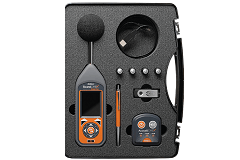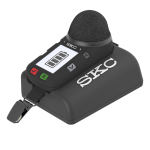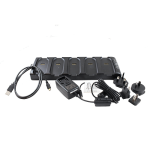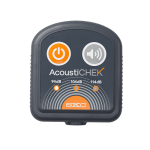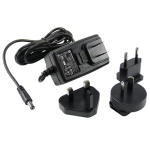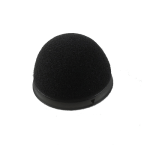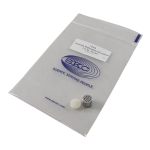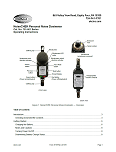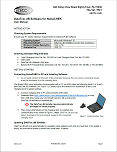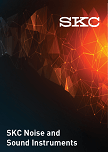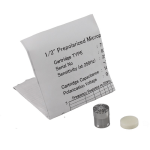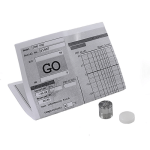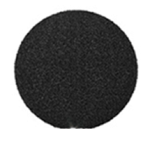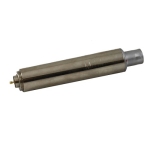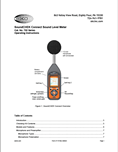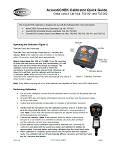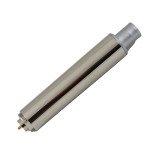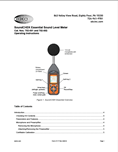SKC NoiseCHEK Dosimeter
- Measures 70 to 140dB
- Simultaneous A and C weighting
- Four programmable virtual dosimeters
- Large configurable display screen
- Small and light for easy worker acceptance
- Up to 180 hours of datalogging and time history
- Intrinsically Safe
- Device lockout for security
- Over 40 hours run rime from a fully charged battery
- Easy automatic calibration using the SKC AcoustiCHEK calibrator
- Locking windshield
- Bluetooth connectivity (optional) with mobile devices using the SmartWave dB App
- DataTrac dB software for dosemeter setup and data management
- Secure magnetic charging docks
-
Specifications
td>Measuring Range 70-140dB, peak up to 143dB Weighting A, C, Z, Peak C or Z weighted Response Time Fast and Slow Standards Meets ANSI S1.25, IEC61252 (Class 2) Operating Time 40+ hours Battery Li-Ion Charge Time 6-8 hours Connectivity Low energy Bluetooth, USB (via charging dock) Ingress Protection IP65 Certification Intrinsic Safety: (SKC Cat. No. 701-001S & 701-001NBS) Class I, Groups A, B, C, D; Class II, Groups E, F, G; Class III, T4; Class I, Zone 0, AEx ia IIC T4 Ga; Ex ia IIC T4 Ga; -20°C ≤ Ta ≤ 45°C
Ex II 1G Ex ia IIC T4 Ga
IECEx UL 21.0026
DEMKO 21ATEX 2537
UL 22UKEX 2456
CE 0539 UKCA 0843Dimensions 9.9 x 4.8 x 5.1 cm (3.9 x 1.9 x 2 in) Weight 117g (4.1 oz) -
NoiseCHEK Dosimeter
Description Pack Size Part Number NoiseCHEK Dosimeter, Intrinscially Safe model (with Bluetooth connectivity).
(requires calibration using AcoustiCHEK calibrator, sold separately)
Requires Charging Dock
Each 701-001S NoiseCHEK Dosimeter, Intrinscially Safe model (no Bluetooth connectivity)
(requires calibration using AcoustiCHEK calibrator, sold separately)
Requires Charging Dock
Each 701-001NBS Other NoiseCHEK models are available including non-Intrinsically Safe models and feature-limited models without Bluetooth®, voice notes, and audio recording. Please contact SKC for more information.
-
NoiseCHEK Dosimeter Kits
Description Part Number NoiseCHEK Dosimeter, 1-Pack Kit, Intrinsically Safe model (with Bluetooth connectivity), includes
Dosimeter, 1-unit charging dock with power supply, USB cable, USB Drive with manual, protective carry case
(requires calibration using AcoustiCHEK calibrator, sold separately)
701-001KS NoiseCHEK Dosimeter, 1-Pack Kit, Intrinsically Safe model (no Bluetooth connectivity), includes
Dosimeter, 1-unit charging dock with power supply, USB cable, USB Drive with manual, protective carry case
(requires calibration using AcoustiCHEK calibrator, sold separately)
701-001KNBS NoiseCHEK Dosimeter, 5-Pack Kit, Intrinsically Safe model (with Bluetooth connectivity), includes
5 x Dosimeters, 5-unit charging dock with power supply, replacement windshield, USB cable, USB Drive with manual, protective carry case
(requires calibration using AcoustiCHEK calibrator, sold separately)
701-001K5S NoiseCHEK Dosimeter, 5-Pack Kit, Intrinsically Safe model (no Bluetooth connectivity), includes
5 x Dosimeters, 5-unit charging dock with power supply, replacement windshield, USB cable, USB Drive with manual, protective carry case
(requires calibration using AcoustiCHEK calibrator, sold separately)
701-001K5NBS Other NoiseCHEK models are available including non-Intrinsically Safe models and feature-limited models without Bluetooth®, voice notes, and audio recording. Please contact SKC for more information.
-
Accessories
Description Pack Size Part Number 1-unit Charging Dock and PC Connection, includes power supply Each 701-002 
5-unit Charging Dock and PC Connection, includes power supply Each 701-003 
AcoustiCHEK Calibrator, includes AA batteries Each 703-002 
Replacement power supply with interchangeable plugs, 100-240V Each 220-600 
Replacement locking Windshield Each 701-004 
NoiseCHEK Replacement Microphone, ½ inch Each 701-005 
Replacement USB Cable for NoiseCHEK Each P71453 
Hard-Sided Single Dosemeter Kit Carry Case which is watertight, airtight, dustproof and crushproof Each 224-916 
Hard-Sided Single Five Dosemeter Kit Carry Case which is watertight, airtight, dustproof and crushproof Each 224-917 
-
Documentation

